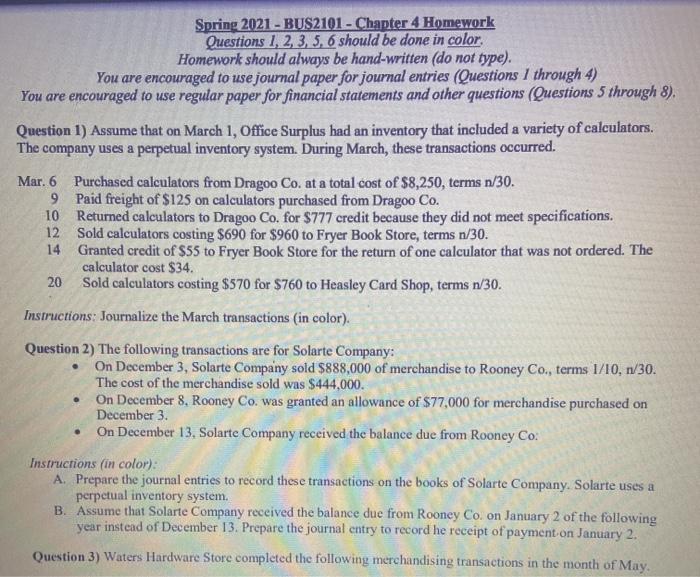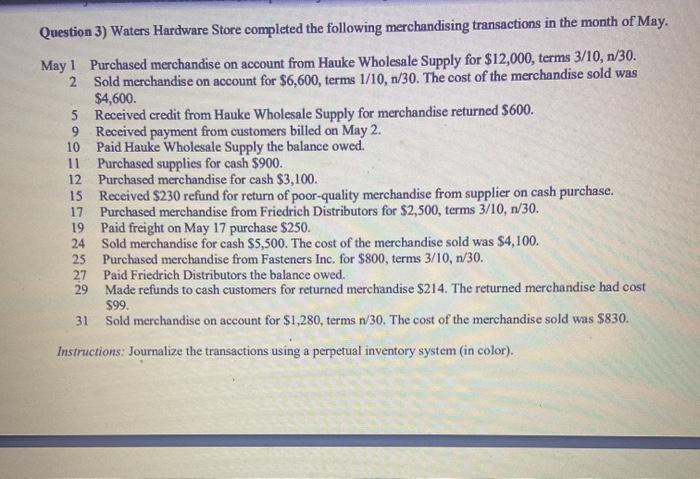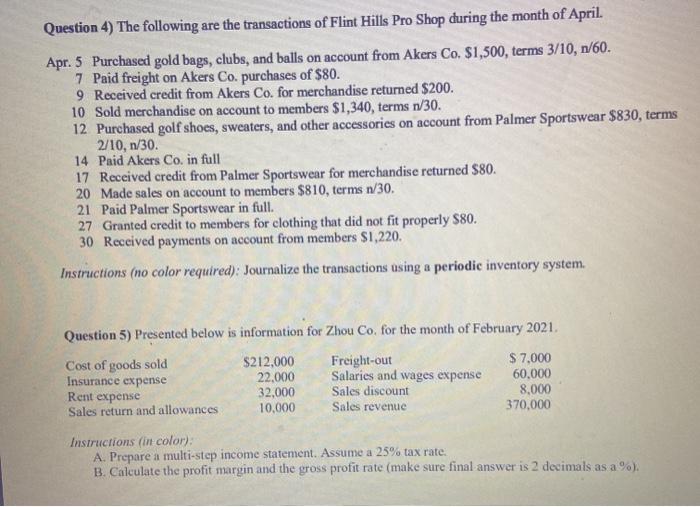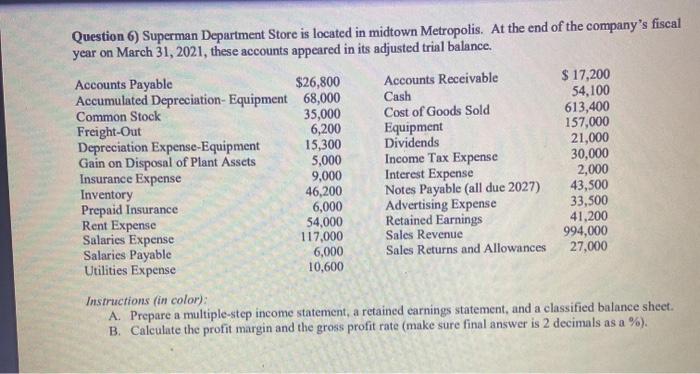Spring 2021 - BUS2101 - Chapter 4 Homework Questions 1, 2, 3, 5, 6 should be done in color Homework should always be hand-written (do not type). You are encouraged to use journal paper for journal entries (Questions / through 4) You are encouraged to use regular paper for financial statements and other questions (Questions through 8). Question 1) Assume that on March 1, Office Surplus had an inventory that included a variety of calculators. The company uses a perpetual inventory system. During March, these transactions occurred. Mar. 6 Purchased calculators from Dragoo Co. at a total cost of $8,250, terms n/30. 9 Paid freight of $125 on calculators purchased from Dragoo Co. 10 Returned calculators to Dragoo Co. for $777 credit because they did not meet specifications. 12 Sold calculators costing $690 for $960 to Fryer Book Store, terms n/30. 14 Granted credit of $55 to Fryer Book Store for the return of one calculator that was not ordered. The calculator cost $34. 20 Sold calculators costing $570 for $760 to Heasley Card Shop, terms n/30. Instructions: Journalize the March transactions (in color). Question 2) The following transactions are for Solarte Company: On December 3, Solarte Company sold $888,000 of merchandise to Rooney Co., terms 1/10, 1/30. The cost of the merchandise sold was $444,000. On December 8, Rooney Co. was granted an allowance of $77,000 for merchandise purchased on December 3. On December 13. Solarte Company received the balance due from Rooney Co: Instructions (in color): A. Prepare the journal entries to record these transactions on the books of Solarte Company. Solarte uses a perpetual inventory system. B. Assume that Solarte Company received the balance due from Rooney Co. on January 2 of the following year instead of December 13. Prepare the journal entry to record he receipt of payment on January 2. Question 3) Waters Hardware Store completed the following merchandising transactions in the month of May. . Question 3) Waters Hardware Store completed the following merchandising transactions in the month of May. May 1 Purchased merchandise on account from Hauke Wholesale Supply for $12,000, terms 3/10, n/30. 2 Sold merchandise on account for $6,600, terms 1/10, 1/30. The cost of the merchandise sold was $4,600 5 Received credit from Hauke Wholesale Supply for merchandise returned $600. 9 Received payment from customers billed on May 2. 10 Paid Hauke Wholesale Supply the balance owed. 11 Purchased supplies for cash $900. 12 Purchased merchandise for cash $3,100. Received $230 refund for return of poor-quality merchandise from supplier on cash purchase. 17 Purchased merchandise from Friedrich Distributors for $2,500, terms 3/10, 1/30. 19 Paid freight on May 17 purchase $250. 24 Sold merchandise for cash $5,500. The cost of the merchandise sold was $4,100. 25 Purchased merchandise from Fasteners Inc. for $800, terms 3/10, n/30. 27 Paid Friedrich Distributors the balance owed. 29 Made refunds to cash customers for returned merchandise $214. The returned merchandise had cost $99. Sold merchandise on account for $1,280, terms /30. The cost of the merchandise sold was $830. Instructions: Journalize the transactions using a perpetual inventory system (in color). 15 31 Question 4) The following are the transactions of Flint Hills Pro Shop during the month of April. Apr. 5 Purchased gold bags, clubs, and balls on account from Akers Co. $1,500, terms 3/10, 1/60. 7 Paid freight on Akers Co. purchases of $80. 9 Received credit from Akers Co. for merchandise returned $200. 10 Sold merchandise on account to members $1,340, terms n/30. 12 Purchased golf shoes, sweaters, and other accessories on account from Palmer Sportswear $830, terms 2/10, n/30. 14 Paid Akers Co. in full 17 Received credit from Palmer Sportswear for merchandise returned $80. 20 Made sales on account to members $810, terms n/30. 21 Paid Palmer Sportswear in full. 27 Granted credit to members for clothing that did not fit properly $80. 30 Received payments on account from members $1,220. Instructions (no color required): Journalize the transactions using a periodic inventory system. Question 5) Presented below is information for Zhou Co, for the month of February 2021 Cost of goods sold $212,000 Freight-out $ 7,000 Insurance expense 22,000 Salaries and wages expense 60.000 Rent expense 32,000 Sales discount 8,000 Sales return and allowances 10,000 Sales revenue 370,000 Instructions (in color): A. Prepare a multi-step income statement. Assume a 25% tax rate. B. Calculate the profit margin and the gross profit rate (make sure final answer is 2 decimals as a %). Question 6) Superman Department Store is located in midtown Metropolis. At the end of the company's fiscal year on March 31, 2021, these accounts appeared in its adjusted trial balance. Accounts Payable $26,800 Accounts Receivable $ 17,200 Accumulated Depreciation Equipment 68,000 Cash 54,100 Common Stock 35,000 Cost of Goods Sold 613,400 Freight-Out 6,200 Equipment 157,000 Depreciation Expense-Equipment 15,300 Dividends 21,000 Gain on Disposal of Plant Assets 5,000 Income Tax Expense 30,000 Insurance Expense 9,000 Interest Expense 2,000 Inventory 46,200 Notes Payable (all due 2027) 43,500 Prepaid Insurance 6,000 Advertising Expense 33,500 Rent Expense 54,000 Retained Earnings 41,200 Salaries Expense 117,000 Sales Revenue 994,000 Salaries Payable 6,000 Sales Returns and Allowances 27,000 Utilities Expense 10,600 Instructions (in color): A. Prepare a multiple-step income statement, a retained earnings statement, and a classified balance sheet. B. Calculate the profit margin and the gross profit rate (make sure final answer is 2 decimals as a %). Question 7) Assume that Tract Company uses a periodic inventory system and has these account balances: Purchases $484,000; Purchase Returns and Allowances $18,000; Purchase Discounts $9,000; Freight-In $16,000, Beginning Inventory $60,000, Net Sales $621,000, and Ending Inventory $90,000. Instructions (no color required): A. Determine Net Purchases and Cost of Goods Purchased. B. Determine Cost of Goods Sold and Gross Profit. Question 8) Below is a series of cost of goods sold sections for companies A, L, N, and R. N $700 (g) 290 7,410 R $G) 43,950 Beginning inventory Purchases Purchases returns and allowances Net purchases Freight-in Cost of goods purchased Cost of goods available for sale Ending inventory Cost of goods sold $250 1,500 80 (a) 130 (b) 1,800 310 (C) $120 1,080 (d) 1.040 (e) 1,230 1,350 (t) 1,230 8,050 42,920 2,420 (1) 49.530 6,230 43.300 1,150 7,600 Instructions (no color required). Fill in the lettered blanks to complete the cost of goods sold sections











